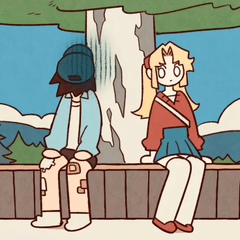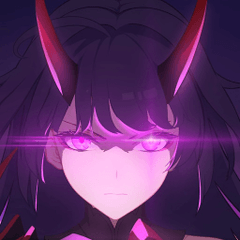Start simple with Simple Mode! How to start drawing on your smartphone with just your fingers
Clip Studio Paint Ver. 2.0.5 or later
Intro
Are you trying out drawing on your smartphone for the first time? Let us walk you through the process of sketching, finishing-up, saving, and sharing your illustration using the smartphone version of Clip Studio Paint.
The smartphone version can be used for free for up to 30 hours every month.
In this article, we will draw an illustration of a girl holding a bouquet. Please read this while trying the steps out for yourself!
Get Clip Studio Paint here
Click here for details on how to use the smartphone version
Create a canvas
First, let’s create a new canvas.
Start Clip Studio Paint and select Screen size from New canvas.
Sketch
Once we have the canvas, we can start sketching.
We will start out by sketching out a rough idea of the silhouette, and go in to refine it.
This is a good way to decide what feel you are going for and to keep the illustration balanced!
Choose a Brush
We will be making a more abstract shape in the beginning so let’s go to Brush > Round watercolor brush.
Choose a Color
Choose a color from Color Wheel or Color Set.
Sketch the rough shape with light blue.
Then start the line sketch with a G-pen in blue.
There are two control sliders on the screen, the upper one controls brush size and the lower one controls opacity.
Slide these right/left to change brush size and opacity.
We can change the brush depending on how detailed we want to go.
Erase Drawn Parts
Tap Switch and change to the Eraser.
Tap the same icon again to go back to Brush.
Draw Line Art
Add a Layer
Let’s add a layer for the line art.
Tap the layer icon to see your layers.
Tap + and make a New Layer.
Lower the Opacity to Draw Line Art More Easily
Tap the sketch layer thumbnail once more and use the slide to lower the opacity.
When the opacity of the layer is lowered then the layer will appear lighter.
Tap the line art layer and start drawing.
Choose black and set your brush to Pencil.
Draw line art over your lightened sketch.
Once your line art is done, open the Layer Palette, then tap the eye icon which will hide your sketch layer.
Congratulations! Your line art is done!
Coloring
For this illustration we will fill in under the sketch and then make a layer for coloring above it.
You could also separate layers for skin, eyes, hair, and so on.
1. Base coloring the character
Make a layer for the base color.
Long press the thumbnail of the added layer and move it under the line art layer.
We will fill in the base color to make sure that the background color does not peek through the character art and that the coloring has coherence.
Make this base with an easily recognizable color so that you can easily see the unpainted areas and the protruding areas.
We recommend that you start along the edges and then fill in the middle, so that even if there is a gap between the fill and the line art it won’t stand out.
Paint the edges with the G-pen so the fill stays within the character lines.
After painting the edges, select Close and paint from Fill to fill in the middle parts.
Open the Layer Palette, tap the base color layer, and select Lock Transparent Pixels.
Once the transparent pixels are locked it means that you can edit only the parts that are visible.
Choose a skin color and use Enclose and fill to change the base color.
2. Paint the skin
Let’s add a layer above the base color layer to use for the skin.
We will paint all the colors of the character on a single layer for this illustration.
Select a more vibrant skin tone from the Color circle and paint the cheeks and nose with Blur watercolor.
Now the cheeks are cute and blushing!
3. Paint the eyes
Paint the base of the eyes with the Round watercolor brush.
After applying the base color, apply several layers of color on the upper part of the eye to make the color darker.
By painting the top of the eyes darker, you can express the shadows of the eyelashes and eyelids, which gives a three-dimensional effect to the eyes.
4. Paint the hair
Use the Rough wash brush to paint the base of the hair.
And then we paint the tips of the hair with a light blue color. This creates a light, airy feel!
Any hair that is over skin will also give the impression of skin peaking through if you paint over with a bit of the skin color.
5. Painting the clothing and flowers
Use Gouache to get the texture of paint for the clothes. The flowers will also be painted with the Gouache brush.
Looking at the balance of colors between the hair and eyes, pick a new color for the flowers.
6. Use Multiply to shade
Make a new layer to put on top of the coloring layer.
Tap the new layer and change the Blending mode to Multiply.
Use the Round watercolor brush to add in shading and wrinkles on the neck, hair, and clothes.
Multiply is really useful to apply to a layer to change the colors underneath, and is especially good for shadows.
And now your character coloring is done!
Use materials for your background
Use materials to make your illustration stand out!
Open the Material palette to get various materials.
Tap the material you want to use to put it on the canvas.
Adjust the position, size, and angle of the material on the preview screen.
Once you have the material in place, move the material layer to the bottom.
And now your background is done!
Finishing Up
Adjust the overall feeling with blending modes.
Let's add a backlight effect to make this illustration more dynamic.
Add Shadows to the Character
Create a new layer on top and change the blending mode to Multiply.
Use the Rough wash brush and paint the entire character and the surroundings with a light orange.
By choosing a color that is close to the colors used in the illustration, the shadow will blend well and more naturally.
Brighten the Edges of the Character
Make a new layer and use Glow dodge.
Use a deep orange with the Round watercolor brush and paint in where the light would hit around the edges and ends of the hair.
Use lines of light to make highlights for a dramatic impression.
If you think the light you drew is too strong, use the Soft eraser to erase it.
Color the Line Art
Make a new layer with Hard light.
With a brush size that is a little thicker than the line art, paint along the line art.
Using the Round watercolor brush with a smaller brush size, draw with vivid light blue around the outside of the hair and the ends of the hair, and draw pink around the face.
By painting light blue and pink near the highlights of the pupil, you can create a sparkle like chromatic aberration.
Left: Blending mode Normal, Right: Hard light
Now we have changed the line drawing from black to colorful, making it even more gorgeous!
Add Shine to the Entire Illustration
Create a Glow dodge layer on top of the other layers.
Add light to the parts you want to shine while using light blue and yellow with a Rough wash brush.
Lower the opacity of the layer in the Layer palette so that the added light doesn’t become too strong.
Look at the balance of the overall illustration to figure out where to add shadows or more details, or even change the opacity level. And now you’re done!
Have fun drawing with the smartphone version of Clip Studio Paint!
How do you save the final illustration data?
In the smartphone version of Clip Studio Paint, data is automatically saved each time you return to the home screen using the back button < located in the upper left corner of the screen.
Furthermore, data is also autosaved at fixed five minute intervals when you draw on the canvas.
However this is the file data for the illustration so you’ll need to save it as an image to share it on social media.
So now let’s export it as a different file format!
Tap ... in the upper right corner of the canvas and select Export image to save and share the image.
From here on, the saving procedure changes depending on whether you are using an Android or an iPhone.
For Android
Tap ... in the upper right corner of the canvas and select Export image to open a window to select Share or Save to device at the bottom of the screen. Selecting either option will display a preview screen.
Select your desired file format (PNG, JPG, PSD) and tap either the Share or Save button to finish exporting the image.
If you tapped the Share button then a pop up window will be displayed. Select a social media platform to share your work.
For iPhone
Tap ... in the upper right corner of the canvas and select Export image to open an image preview screen.
Select your desired file format (PNG, JPG, PSD) and press the Share button to open the sharing destination selection screen. Select a social media platform to share your work.
You can save the image to your smartphone with Save Image.
Share timelapse
A timelapse shows a sped-up version of the process of your illustration creation.
You can see how you drew, so you can review it and learn how other people approach making illustrations and how it differs from your approach.
In the smartphone version of Clip Studio Paint, timelapse is recorded by default.
Tap ... in the upper right corner of the canvas and select Export timelapse to open an image preview screen.
In Android, selecting Export timelapse will open a window to select Share or Save to device at the bottom of the screen. To share on social media, select Share, and to save the data to your device, select Save to device.
From the Export timelapse screen, you can choose the video length, size, ratio, and whether or not to have a logo.
Save (export) your illustration process as a new timelapse and share it on social media!
























Comment